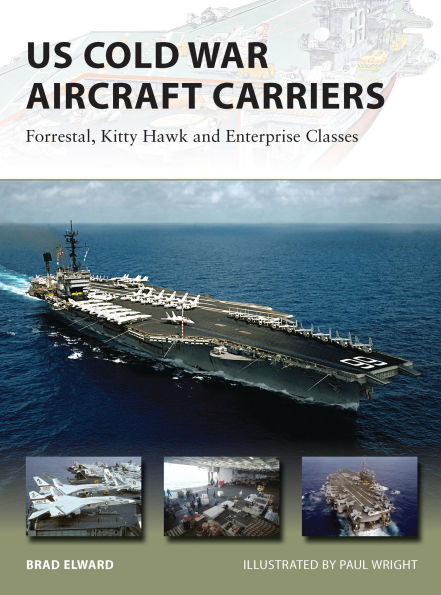The Forrestal class (Forrestal, CV-59; Saratoga, CV-60; Ranger, CV-61 and Independence, CV-62) was the first completed class of US Navy supercarriers, so-named for their 25 percent size increase over the World War II-era carriers such as the Midway class, and the strength of their air wings (80-100 aircraft, compared to 65-75 for the Midway, and fewer than 50 for the Essex class). Design-wise, the Forrestals were a huge improvement over their predecessors, being more stable and comfortable, while maintaining advancements such as the armored flight decks that had been introduced with the Midway. The Kitty Hawk class was an improvement on the Forrestal-class designs, and four were built in the 1960s - Kitty Hawk (CV-63), Constellation (CV-64), America (CV-66) and John F. Kennedy (CV-67). These were even longer than the Forrestals, and fitted with advanced defensive weapons systems and an improved elevator layout. John F. Kennedy, while originally intended as one of the Kitty Hawk class, received so many modifications during construction that she essentially formed her own class, and was originally planned to become the US Navy's first nuclear-powered carrier. This plan never came to fruition, however, and that honor was left to her successor, USS Enterprise (CVN-65). The only ship of her class, Enterprise holds several other distinctions - the longest naval vessel in the world, the second-oldest commissioned vessel in the US Navy (after the USS Constitution), and, when retired in 2013, will have served 51 years - far longer than any other US carrier. All nine of the carriers covered by this volume are icons, and hold a much-respected place in US naval history. They are also some of the more well-known vessels outside of the military, for their long service histories, as well as for some of the more unfortunate events that seem to follow them - from Kitty Hawk's infamous 1972 "grilled cheese" race riot, to the fires that ravaged Forrestal in 1967 and Enterprise in 1969. Though swiftly superseded, first by each other, then by the Nimitz class, these vessels were the US Navy's backbone during the Cold War.
The Forrestal class (Forrestal, CV-59; Saratoga, CV-60; Ranger, CV-61 and Independence, CV-62) was the first completed class of US Navy supercarriers, so-named for their 25 percent size increase over the World War II-era carriers such as the Midway class, and the strength of their air wings (80-100 aircraft, compared to 65-75 for the Midway, and fewer than 50 for the Essex class). Design-wise, the Forrestals were a huge improvement over their predecessors, being more stable and comfortable, while maintaining advancements such as the armored flight decks that had been introduced with the Midway. The Kitty Hawk class was an improvement on the Forrestal-class designs, and four were built in the 1960s - Kitty Hawk (CV-63), Constellation (CV-64), America (CV-66) and John F. Kennedy (CV-67). These were even longer than the Forrestals, and fitted with advanced defensive weapons systems and an improved elevator layout. John F. Kennedy, while originally intended as one of the Kitty Hawk class, received so many modifications during construction that she essentially formed her own class, and was originally planned to become the US Navy's first nuclear-powered carrier. This plan never came to fruition, however, and that honor was left to her successor, USS Enterprise (CVN-65). The only ship of her class, Enterprise holds several other distinctions - the longest naval vessel in the world, the second-oldest commissioned vessel in the US Navy (after the USS Constitution), and, when retired in 2013, will have served 51 years - far longer than any other US carrier. All nine of the carriers covered by this volume are icons, and hold a much-respected place in US naval history. They are also some of the more well-known vessels outside of the military, for their long service histories, as well as for some of the more unfortunate events that seem to follow them - from Kitty Hawk's infamous 1972 "grilled cheese" race riot, to the fires that ravaged Forrestal in 1967 and Enterprise in 1969. Though swiftly superseded, first by each other, then by the Nimitz class, these vessels were the US Navy's backbone during the Cold War.

US Cold War Aircraft Carriers: Forrestal, Kitty Hawk and Enterprise Classes
48
US Cold War Aircraft Carriers: Forrestal, Kitty Hawk and Enterprise Classes
48
Product Details
| ISBN-13: | 9781782003809 |
|---|---|
| Publisher: | Bloomsbury USA |
| Publication date: | 03/18/2014 |
| Series: | New Vanguard , #211 |
| Pages: | 48 |
| Product dimensions: | 9.50(w) x 7.10(h) x 0.10(d) |
